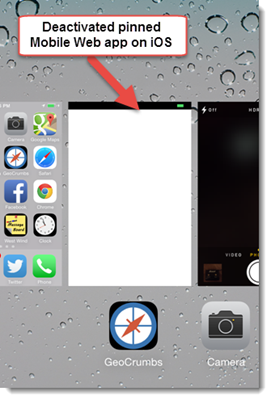The broken Promise of the Mobile Web
Posted
by Rick Strahl
on West-Wind
See other posts from West-Wind
or by Rick Strahl
Published on Mon, 18 Aug 2014 18:00:00 GMT
Indexed on
2014/08/18
22:21 UTC
Read the original article
Hit count: 992
 High end mobile devices have been with us now for almost 7 years and they have utterly transformed the way we access information. Mobile phones and smartphones that have access to the Internet and host smart applications are in the hands of a large percentage of the population of the world. In many places even very remote, cell phones and even smart phones are a common sight.
High end mobile devices have been with us now for almost 7 years and they have utterly transformed the way we access information. Mobile phones and smartphones that have access to the Internet and host smart applications are in the hands of a large percentage of the population of the world. In many places even very remote, cell phones and even smart phones are a common sight.
I’ll never forget when I was in India in 2011 I was up in the Southern Indian mountains riding an elephant out of a tiny local village, with an elephant herder in front riding atop of the elephant in front of us. He was dressed in traditional garb with the loin wrap and head cloth/turban as did quite a few of the locals in this small out of the way and not so touristy village. So we’re slowly trundling along in the forest and he’s lazily using his stick to guide the elephant and… 10 minutes in he pulls out his cell phone from his sash and starts texting. In the middle of texting a huge pig jumps out from the side of the trail and he takes a picture running across our path in the jungle! So yeah, mobile technology is very pervasive and it’s reached into even very buried and unexpected parts of this world.
Apps are still King
Apps currently rule the roost when it comes to mobile devices and the applications that run on them. If there’s something that you need on your mobile device your first step usually is to look for an app, not use your browser. But native app development remains a pain in the butt, with the requirement to have to support 2 or 3 completely separate platforms.
There are solutions that try to bridge that gap. Xamarin is on a tear at the moment, providing their cross-device toolkit to build applications using C#. While Xamarin tools are impressive – and also *very* expensive – they only address part of the development madness that is app development. There are still specific device integration isssues, dealing with the different developer programs, security and certificate setups and all that other noise that surrounds app development.
There’s also PhoneGap/Cordova which provides a hybrid solution that involves creating local HTML/CSS/JavaScript based applications, and then packaging them to run in a specialized App container that can run on most mobile device platforms using a WebView interface. This allows for using of HTML technology, but it also still requires all the set up, configuration of APIs, security keys and certification and submission and deployment process just like native applications – you actually lose many of the benefits that Web based apps bring. The big selling point of Cordova is that you get to use HTML have the ability to build your UI once for all platforms and run across all of them – but the rest of the app process remains in place.
Apps can be a big pain to create and manage especially when we are talking about specialized or vertical business applications that aren’t geared at the mainstream market and that don’t fit the ‘store’ model. If you’re building a small intra department application you don’t want to deal with multiple device platforms and certification etc. for various public or corporate app stores. That model is simply not a good fit both from the development and deployment perspective.
Even for commercial, big ticket apps, HTML as a UI platform offers many advantages over native, from write-once run-anywhere, to remote maintenance, single point of management and failure to having full control over the application as opposed to have the app store overloads censor you.
In a lot of ways Web based HTML/CSS/JavaScript applications have so much potential for building better solutions based on existing Web technologies for the very same reasons a lot of content years ago moved off the desktop to the Web.
To me the Web as a mobile platform makes perfect sense, but the reality of today’s Mobile Web unfortunately looks a little different…
Where’s the Love for the Mobile Web?
Yet here we are in the middle of 2014, nearly 7 years after the first iPhone was released and brought the promise of rich interactive information at your fingertips, and yet we still don’t really have a solid mobile Web platform.
I know what you’re thinking: “But we have lots of HTML/JavaScript/CSS features that allows us to build nice mobile interfaces”. I agree to a point – it’s actually quite possible to build nice looking, rich and capable Web UI today. We have media queries to deal with varied display sizes, CSS transforms for smooth animations and transitions, tons of CSS improvements in CSS 3 that facilitate rich layout, a host of APIs geared towards mobile device features and lately even a number of JavaScript framework choices that facilitate development of multi-screen apps in a consistent manner.
Personally I’ve been working a lot with AngularJs and heavily modified Bootstrap themes to build mobile first UIs and that’s been working very well to provide highly usable and attractive UI for typical mobile business applications. From the pure UI perspective things actually look very good.
Not just about the UI
But it’s not just about the UI - it’s also about integration with the mobile device. When it comes to putting all those pieces together into what amounts to a consolidated platform to build mobile Web applications, I think we still have a ways to go… there are a lot of missing pieces to make it all work together and integrate with the device more smoothly, and more importantly to make it work uniformly across the majority of devices.
I think there are a number of reasons for this.
Slow Standards Adoption
HTML standards implementations and ratification has been dreadfully slow, and browser vendors all seem to pick and choose different pieces of the technology they implement. The end result is that we have a capable UI platform that’s missing some of the infrastructure pieces to make it whole on mobile devices. There’s lots of potential but what is lacking that final 10% to build truly compelling mobile applications that can compete favorably with native applications.
 Some of it is the fragmentation of browsers and the slow evolution of the mobile specific HTML APIs. A host of mobile standards exist but many of the standards are in the early review stage and they have been there stuck for long periods of time and seem to move at a glacial pace. Browser vendors seem even slower to implement them, and for good reason – non-ratified standards mean that implementations may change and vendor implementations tend to be experimental and likely have to be changed later. Neither Vendors or developers are not keen on changing standards. This is the typical chicken and egg scenario, but without some forward momentum from some party we end up stuck in the mud. It seems that either the standards bodies or the vendors need to carry the torch forward and that doesn’t seem to be happening quickly enough.
Some of it is the fragmentation of browsers and the slow evolution of the mobile specific HTML APIs. A host of mobile standards exist but many of the standards are in the early review stage and they have been there stuck for long periods of time and seem to move at a glacial pace. Browser vendors seem even slower to implement them, and for good reason – non-ratified standards mean that implementations may change and vendor implementations tend to be experimental and likely have to be changed later. Neither Vendors or developers are not keen on changing standards. This is the typical chicken and egg scenario, but without some forward momentum from some party we end up stuck in the mud. It seems that either the standards bodies or the vendors need to carry the torch forward and that doesn’t seem to be happening quickly enough.
Mobile Device Integration just isn’t good enough
Current standards are not far reaching enough to address a number of the use case scenarios necessary for many mobile applications. While not every application needs to have access to all mobile device features, almost every mobile application could benefit from some integration with other parts of the mobile device platform. Integration with GPS, phone, media, messaging, notifications, linking and contacts system are benefits that are unique to mobile applications and could be widely used, but are mostly (with the exception of GPS) inaccessible for Web based applications today.
Unfortunately trying to do most of this today only with a mobile Web browser is a losing battle. Aside from PhoneGap/Cordova’s app centric model with its own custom API accessing mobile device features and the token exception of the GeoLocation API, most device integration features are not widely supported by the current crop of mobile browsers. For example there’s no usable messaging API that allows access to SMS or contacts from HTML. Even obvious components like the Media Capture API are only implemented partially by mobile devices. There are alternatives and workarounds for some of these interfaces by using browser specific code, but that’s might ugly and something that I thought we were trying to leave behind with newer browser standards. But it’s not quite working out that way.
It’s utterly perplexing to me that mobile standards like Media Capture and Streams, Media Gallery Access, Responsive Images, Messaging API, Contacts Manager API have only minimal or no traction at all today. Keep in mind we’ve had mobile browsers for nearly 7 years now, and yet we still have to think about how to get access to an image from the image gallery or the camera on some devices? Heck Windows Phone IE Mobile just gained the ability to upload images recently in the Windows 8.1 Update – that’s feature that HTML has had for 20 years! These are simple concepts and common problems that should have been solved a long time ago.
It’s extremely frustrating to see build 90% of a mobile Web app with relative ease and then hit a brick wall for the remaining 10%, which often can be show stoppers. The remaining 10% have to do with platform integration, browser differences and working around the limitations that browsers and ‘pinned’ applications impose on HTML applications.
The maddening part is that these limitations seem arbitrary as they could easily work on all mobile platforms. For example, SMS has a URL Moniker interface that sort of works on Android, works badly with iOS (only works if the address is already in the contact list) and not at all on Windows Phone. There’s no reason this shouldn’t work universally using the same interface – after all all phones have supported SMS since before the year 2000!
But, it doesn’t have to be this way
Change can happen very quickly. Take the GeoLocation API for example. Geolocation has taken off at the very beginning of the mobile device era and today it works well, provides the necessary security (a big concern for many mobile APIs), and is supported by just about all major mobile and even desktop browsers today. It handles security concerns via prompts to avoid unwanted access which is a model that would work for most other device APIs in a similar fashion. One time approval and occasional re-approval if code changes or caches expire. Simple and only slightly intrusive. It all works well, even though GeoLocation actually has some physical limitations, such as representing the current location when no GPS device is present. Yet this is a solved problem, where other APIs that are conceptually much simpler to implement have failed to gain any traction at all.
Technically none of these APIs should be a problem to implement, but it appears that the momentum is just not there.
Inadequate Web Application Linking and Activation
Another important piece of the puzzle missing is the integration of HTML based Web applications. Today HTML based applications are not first class citizens on mobile operating systems.
When talking about HTML based content there’s a big difference between content and applications. Content is great for search engine discovery and plain browser usage. Content is usually accessed intermittently and permanent linking is not so critical for this type of content. But applications have different needs. Applications need to be started up quickly and must be easily switchable to support a multi-tasking user workflow. Therefore, it’s pretty crucial that mobile Web apps are integrated into the underlying mobile OS and work with the standard task management features. Unfortunately this integration is not as smooth as it should be.
It starts with actually trying to find mobile Web applications, to ‘installing’ them onto a phone in an easily accessible manner in a prominent position. The experience of discovering a Mobile Web ‘App’ and making it sticky is by no means as easy or satisfying. Today the way you’d go about this is:
- Open the browser
- Search for a Web Site in the browser with your
search engine of choice - Hope that you find the right site
- Hope that you actually find a site that works for your mobile device
- Click on the link and run the app in a fully chrome’d browser instance (read tiny surface area)
- Pin the app to the home screen (with all the limitations outline above)
- Hope you pointed at the right URL when you pinned
Even for you and me as developers, there are a few steps in there that are painful and annoying, but think about the average user. First figuring out how to search for a specific site or URL? And then pinning the app and hopefully from the right location? You’ve probably lost more than half of your audience at that point.
This experience sucks.
For developers too this process is painful since app developers can’t control the shortcut creation directly. This problem often gets solved by crazy coding schemes, with annoying pop-ups that try to get people to create shortcuts via fancy animations that are both annoying and add overhead to each and every application that implements this sort of thing differently.
And that’s not the end of it - getting the link onto the home screen with an application icon varies quite a bit between browsers. Apple’s non-standard meta tags are prominent and they work with iOS and Android (only more recent versions), but not on Windows Phone. Windows Phone instead requires you to create an actual screen or rather a partial screen be captured for a shortcut in the tile manager. Who had that brilliant idea I wonder? Surprisingly Chrome on recent Android versions seems to actually get it right – icons use pngs, pinning is easy and pinned applications properly behave like standalone apps and retain the browser’s active page state and content. Each of the platforms has a different way to specify icons (WP doesn’t allow you to use an icon image at all), and the most widely used interface in use today is a bunch of Apple specific meta tags that other browsers choose to support.
The question is: Why is there no standard implementation for installing shortcuts across mobile platforms using an official format rather than a proprietary one?
 Then there’s iOS and the crazy way it treats home screen linked URLs using a crazy hybrid format that is neither as capable as a Web app running in Safari nor a WebView hosted application. Moving off the Web ‘app’ link when switching to another app actually causes the browser and preview it to ‘blank out’ the Web application in the Task View (see screenshot on the right). Then, when the ‘app’ is reactivated it ends up completely restarting the browser with the original link. This is crazy behavior that you can’t easily work around. In some situations you might be able to store the application state and restore it using LocalStorage, but for many scenarios that involve complex data sources (like say Google Maps) that’s not a possibility. The only reason for this screwed up behavior I can think of is that it is deliberate to make Web apps a pain in the butt to use and forcing users trough the App Store/PhoneGap/Cordova route.
Then there’s iOS and the crazy way it treats home screen linked URLs using a crazy hybrid format that is neither as capable as a Web app running in Safari nor a WebView hosted application. Moving off the Web ‘app’ link when switching to another app actually causes the browser and preview it to ‘blank out’ the Web application in the Task View (see screenshot on the right). Then, when the ‘app’ is reactivated it ends up completely restarting the browser with the original link. This is crazy behavior that you can’t easily work around. In some situations you might be able to store the application state and restore it using LocalStorage, but for many scenarios that involve complex data sources (like say Google Maps) that’s not a possibility. The only reason for this screwed up behavior I can think of is that it is deliberate to make Web apps a pain in the butt to use and forcing users trough the App Store/PhoneGap/Cordova route.
App linking and management is a very basic problem – something that we essentially have solved in every desktop browser – yet on mobile devices where it arguably matters a lot more to have easy access to web content we have to jump through hoops to have even a remotely decent linking/activation experience across browsers.
Where’s the Money?
It’s not surprising that device home screen integration and Mobile Web support in general is in such dismal shape – the mobile OS vendors benefit financially from App store sales and have little to gain from Web based applications that bypass the App store and the cash cow that  it presents.
it presents.
On top of that, platform specific vendor lock-in of both end users and developers who have invested in hardware, apps and consumables is something that mobile platform vendors actually aspire to. Web based interfaces that are cross-platform are the anti-thesis of that and so again it’s no surprise that the mobile Web is on a struggling path.
But – that may be changing. More and more we’re seeing operations shifting to services that are subscription based or otherwise collect money for usage, and that may drive more progress into the Web direction in the end . Nothing like the almighty dollar to drive innovation forward.
Do we need a Mobile Web App Store?
As much as I dislike moderated experiences in today’s massive App Stores, they do at least provide one single place to look for apps for your device.
I think we could really use some sort of registry, that could provide something akin to an app store for mobile Web apps, to make it easier to actually find mobile applications. This could take the form of a specialized search engine, or maybe a more formal store/registry like structure. Something like apt-get/chocolatey for Web apps. It could be curated and provide at least some feedback and reviews that might help with the integrity of applications.
Coupled to that could be a native application on each platform that would allow searching and browsing of the registry and then also handle installation in the form of providing the home screen linking, plus maybe an initial security configuration that determines what features are allowed access to for the app.
I’m not holding my breath. In order for this sort of thing to take off and gain widespread appeal, a lot of coordination would be required. And in order to get enough traction it would have to come from a well known entity – a mobile Web app store from a no name source is unlikely to gain high enough usage numbers to make a difference. In a way this would eliminate some of the freedom of the Web, but of course this would also be an optional search path in addition to the standard open Web search mechanisms to find and access content today.
Security
Security is a big deal, and one of the perceived reasons why so many IT professionals appear to be willing to go back to the walled garden of deployed apps is that Apps are perceived as safe due to the official review and curation of the App stores. Curated stores are supposed to protect you from malware, illegal and misleading content. It doesn’t always work out that way and all the major vendors have had issues with security and the review process at some time or another.
Security is critical, but I also think that Web applications in general pose less of a security threat than native applications, by nature of the sandboxed browser and JavaScript environments. Web applications run externally completely and in the HTML and JavaScript sandboxes, with only a very few controlled APIs allowing access to device specific features.
And as discussed earlier – security for any device interaction can be granted the same for mobile applications through a Web browser, as they can for native applications either via explicit policies loaded from the Web, or via prompting as GeoLocation does today. Security is important, but it’s certainly solvable problem for Web applications even those that need to access device hardware.
Security shouldn’t be a reason for Web apps to be an equal player in mobile applications.
Apps are winning, but haven’t we been here before?
So now we’re finding ourselves back in an era of installed app, rather than Web based and managed apps. Only it’s even worse today than with Desktop applications, in that the apps are going through a gatekeeper that charges a toll and censors what you can and can’t do in your apps. Frankly it’s a mystery to me why anybody would buy into this model and why it’s lasted this long when we’ve already been through this process. It’s crazy…
It’s really a shame that this regression is happening. We have the technology to make mobile Web apps much more prominent, but yet we’re basically held back by what seems little more than bureaucracy, partisan bickering and self interest of the major parties involved. Back in the day of the desktop it was Internet Explorer’s 98+% market shareholding back the Web from improvements for many years – now it’s the combined mobile OS market in control of the mobile browsers.
If mobile Web apps were allowed to be treated the same as native apps with simple ways to install and run them consistently and persistently, that would go a long way to making mobile applications much more usable and seriously viable alternatives to native apps. But as it is mobile apps have a severe disadvantage in placement and operation.
There are a few bright spots in all of this.
Mozilla’s FireFoxOs is embracing the Web for it’s mobile OS by essentially  building every app out of HTML and JavaScript based content. It supports both packaged and certified package modes (that can be put into the app store), and Open Web apps that are loaded and run completely off the Web and can also cache locally for offline operation using a manifest. Open Web apps are treated as full class citizens in FireFoxOS and run using the same mechanism as installed apps.
building every app out of HTML and JavaScript based content. It supports both packaged and certified package modes (that can be put into the app store), and Open Web apps that are loaded and run completely off the Web and can also cache locally for offline operation using a manifest. Open Web apps are treated as full class citizens in FireFoxOS and run using the same mechanism as installed apps.
Unfortunately FireFoxOs is getting a slow start with minimal device support and specifically targeting the low end market. We can hope that this approach will change and catch on with other vendors, but that’s also an uphill battle given the conflict of interest with platform lock in that it represents.
Recent versions of Android also seem to be working reasonably well with mobile application integration onto the desktop and activation out of the box. Although it still uses the Apple meta tags to find icons and behavior settings, everything at least works as you would expect – icons to the desktop on pinning, WebView based full screen activation, and reliable application persistence as the browser/app is treated like a real application. Hopefully iOS will at some point provide this same level of rudimentary Web app support.
What’s also interesting to me is that Microsoft hasn’t picked up on the obvious need for a solid Web App platform. Being a distant third in the mobile OS war, Microsoft certainly has nothing to lose and everything to gain by using fresh ideas and expanding into areas that the other major vendors are neglecting. But instead Microsoft is trying to beat the market leaders at their own game, fighting on their adversary’s terms instead of taking a new tack. Providing a kick ass mobile Web platform that takes the lead on some of the proposed mobile APIs would be something positive that Microsoft could do to improve its miserable position in the mobile device market.
Where are we at with Mobile Web?
It sure sounds like I’m really down on the Mobile Web, right? I’ve built a number of mobile apps in the last year and while overall result and response has been very positive to what we were able to accomplish in terms of UI, getting that final 10% that required device integration dialed was an absolute nightmare on every single one of them. Big compromises had to be made and some features were left out or had to be modified for some devices. In two cases we opted to go the Cordova route in order to get the integration we needed, along with the extra pain involved in that process. Unless you’re not integrating with device features and you don’t care deeply about a smooth integration with the mobile desktop, mobile Web development is fraught with frustration.
So, yes I’m frustrated! But it’s not for lack of wanting the mobile Web to succeed. I am still a firm believer that we will eventually arrive a much more functional mobile Web platform that allows access to the most common device features in a sensible way.
It wouldn't be difficult for device platform vendors to make Web based applications first class citizens on mobile devices.
But unfortunately it looks like it will still be some time before this happens.
So, what’s your experience building mobile Web apps? Are you finding similar issues? Just giving up on raw Web applications and building PhoneGap apps instead? Completely skipping the Web and going native? Leave a comment for discussion.
Resources
© West-Wind or respective owner
